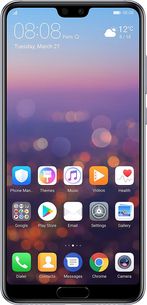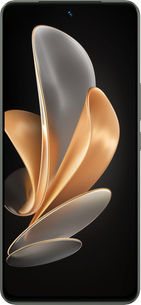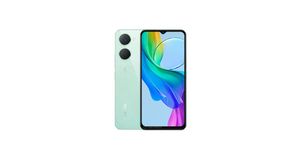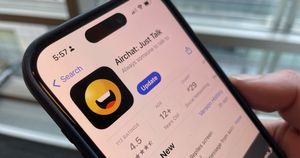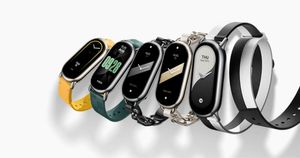
Most flagship-class smartphones launched by Huawei have until now remained one step behind the competition when it came to imaging and processing prowess. Handsets like the Huawei P9 and P10, for example, were excellent devices – but for some reason, did not manage to garner as much attention they deserved. This time, however, it seems Huawei has decided to up the ante. Not only does the new Huawei P20 Pro pack one of the most powerful processors currently available for smartphones, but the handset also boasts of a Leica-branded triple-camera setup that Huawei claims to be amongst the best in business. This is of course apart from a very premium design that the phone sports. We have been trying to get hold of the P20 Pro ever since it was launched in India, and ended up buying our own device for the sake of this review. We did eventually get a review unit from Huawei that we intend to use for our long-term tests.
Huawei P20 Pro
Rs. 64,999What Is Good?
- Beautiful design and robust build quality
- Excellent image quality from primary and secondary camera
- Fast and smooth performance
- UI has plenty of features
- Battery backup better than most flagships
What Is Bad?
- Display lacks HDR
- No 4K/60FPS video recording
- UI design looks outdated in some places
- Battery takes a long time to charge
Huawei P20 Pro Review: Design and Build Quality
Huawei has left no stone unturned in making the P20 Pro look beautiful. The unique curved rear glass panel with the triple camera setup looks classy, and even though the panel looks a tad ‘crowded’ with the three camera lenses and the LED flash unit, the overall design is quite attractive. The glass panel has a mirror finish to it. Our review unit was the Dark Blue variant that looks absolutely gorgeous in daylight. The camera module and the buttons have chamfered edges, and there is the pronounced LEICA branding below the camera lens – all of which add to the premium look of the device. The only issue I found with the design was the placement of the fingerprint scanner which in my opinion disrupts the seamlessness of the beautiful bezel-less display.
During the course of my usage that lasted around two weeks, I (inadvertently) dropped the phone a couple of times, and to my surprise, the handset was built well enough to come out those without a single scratch. Another testament to the P20 Pro’s durability was its resistance to damage from daily wear and tear. I have this habit of keeping keys and other stuff in my pockets along with the smartphone, and it had become a norm for most of my smartphones to end up with tell-tale signs of damage within a few weeks of use. In fact, most of the smartphones that I use end up with a scratched display in less than a month. The P20, however, was an exception and remains scratch-free to this day.
It is evident, therefore, that the P20 is as well-built as it is beautiful. Thanks to the rock-solid build quality, holding the P20 Pro in hand feels like holding a slab of metal. The device shows no sign of frame flex, and it doesn’t make those freaky creaky sounds when you attempt to bend the device. The P20 Pro is also one of the most comfortable devices to hold, thanks to its curved sides. When compared to other flagship smartphones – including the likes of the Samsung Galaxy S9+ and the Apple iPhone X – the Huawei P20 Pro feels better built of the two.
Huawei P20 Pro Review: Display
The Huawei P20 Pro has a 6.1-inch display that uses the newer 18.7:9 aspect ratio. This is an AMOLED panel with a resolution of 1080 x 2240 pixels. As the norm is, the phone also gets a tiny notch at the top of the display. Thankfully, for all notch haters like me, the phone offers an easy option to hide the notch completely.
Being an AMOLED display, the P20 Pro has a very vivid colour tone and displays true blacks. The viewing angles are excellent as well. Perhaps the only downside is the fact that most of the other flagship class devices in this price range offer a higher resolution QHD+ display. That said, there is no denying that the Full HD+ panel on the P20 Pro is more than adequate for most users. The AMOLED panel on the P20 Pro is quite bright, and the display is easy to use even under direct sunlight. The panel is also able to display even the smallest of the icons and the text with incredible sharpness. Another feature that the display of the Huawei P20 Pro misses out on is HDR10 compatibility. Overall though, the P20 Pro’s display is among the best on offer today.
Huawei P20 Pro Review: Camera
The Huawei P20 Pro features a 40MP + 20MP + 8MP triple camera setup thereby making its imaging intentions pretty clear. The handset also gets a premium Leica lens for the primary camera. While the 40MP camera uses a regular RGB sensor, the 20MP camera gets a dedicated monochrome sensor. The smaller 8MP camera, on the other hand, gets a telephoto lens that supports 3x optical zoom. The P20 Pro combines the images from the RGB and the monochrome sensors to produce a more detailed image. The primary camera can also capture images with bokeh effect, thanks to the dedicated telephoto lens and Huawei’s own Master AI. At the front, the phone features a single 24MP camera with Leica lens and support for portrait mode. Let’s take a look at the images captured by the P20 Pro.
Primary Camera: Image Quality
The image quality from the primary camera in daylight is superb. Most of the images captured in daylight have excellent details and have vivid colours. I did not find any hint of noise or over-sharpening effects in these images. Even though the camera misses out on dual-pixel autofocus, the combination of phase and laser detection autofocus that it comes with works flawlessly. The focusing is fast and accurate and not once did the camera show signs of lag or delay in focusing during my entire review period.
The low light images captured by the phone also have excellent quality, thanks to support for OIS and the fact that the handset gets a monochrome sensor. The images captured under low light situations turn out bright, detailed, and have very less noise. To compare, I captured the same subjects using the Honor P20 Pro and the OnePlus 6 in similar lowlight situations. Unsurprisingly, the P20 Pro is clearly better at low light imaging than the OnePlus 6. Not only did the P20 Pro manage to capture more details, even the colours were closer to reality.
I was also left impressed by the lens quality of the Huawei P20 Pro. Just a few days into my testing, it became evident that Leica lens used by the phone is of top-notch quality and that it was not a simple exercise in co-branding. One of the things that the high-quality Leica lens enables is the distinct reduction in the amount of lens flare. The lower lens flare helps the camera capture more details and endows it with superior dynamic range.
The images captured using the telephoto lens with 3x zoom are also very detailed, vivid, and sharp. Again, just like the standard FoV images, the zoomed images are also noise-free in daylight in spite of the lens using f/2.6 aperture. However, the image quality from the telephoto camera takes a hit under low light situations. That, however, is the case with the telephoto camera on all high-end smartphones, so I wouldn’t really complain.
Primary Camera: Portrait Mode & Panorama
The Huawei P20 Pro also has a portrait mode that can capture images with bokeh effect (also known as background blur). The portrait mode takes help of Huawei’s Master AI and its additional camera sensors. The best part of the portrait mode is that the FoV remains same, unlike the portrait mode on iPhones where you get a narrow FoV.
The portrait images come out as they should; the subject or the person is very well differentiated from the background. The colours and the brightness are also very well maintained. The portrait mode also has 3D lighting effects which looks a total rip-off from the iPhone X. The 3D-lighting works but not all the times, and when it works, it does not make a significant difference in lighting. I hope Huawei improves this with a software update.
The Huawei P20 Pro also captures high-resolution panoramas. The panoramas have a maximum resolution of 34.5-megapixels. The stitching between images is flawless, and the change in exposure is also well managed. Overall, the panorama mode on the P20 Pro is excellent.
Primary Camera: Video Recording
All the flagship class handsets released in 2018 feature 4K video recording at 60fps. This feature, however, is missing on the Huawei P20 Pro. While this would have been excusable if the P20 Pro was priced under the Rs.40,000 mark, for a handset that costs Rs.65,000, this is a glaring omission. Anyone buying a smartphone worth Rs. 64,999 would want 4K/60FPS video recording, and the lack of it will hugely impact the sales of the P20 Pro in my opinion. All said, the phone does support 4K/30FPS video recording, which we found to be excellent. The videos have a vibrant colour tone, and the focusing is fast and accurate.
Editor’s Note: We did, however, notice that the P20 Pro has an issue maintaining focus under certain lighting conditions. For example, the handset fails to maintain focus on the background while capturing scenes from an aeroplane window. The handset has this tendency to lose focus and re-focus on subjects in the foreground (for example, a dust speck on the plane window). This was an annoying issue that we hope Huawei addresses in future software updates.
The video stabilisation is spectacular, thanks to support for OIS. However, you do not get OIS in the high-quality 1080p60 and 4K30 recording modes. The audio recording quality was excellent as well with good separation between the left and right audio channels.
The device can also record 960FPS slow-motion videos at HD resolution, and 120FPS slow-motion videos at Full HD resolution. The 960FPS recording is fantastic but not very useful due to its narrow time frame and lower quality. However, the 120FPS video recording at Full HD doesn’t suffer from either of these issues.
Secondary Camera: Image Quality & Video Recording
Just like the primary camera, the secondary camera of the P20 Pro also has excellent image quality. The images come out bright, sharp, vivid, and detailed. The camera also has a portrait mode, and it works wonderfully. The images captured in the portrait mode are excellent with clear differentiation between the subject and background. In fact, these images look like they have been captured using a DSLR. It’s that good!
Selfies captured under low light conditions also come out bright and have a very low amount of noise. There is also display flash, but it can’t be turned on manually, which is a bummer. The display flash will only turn on if the camera recognises a low light scene.
The front-facing camera can record Full HD videos and is aided by EIS. The videos have a vivid colour tone, display a good amount of detail, and have decent dynamic range as well. Thanks to the EIS, the shake while recording is well managed.
Huawei P20 Pro Review: Performance
The Huawei P20 Pro uses the HiSilicon Kirin 970 SoC, which is currently one of the most powerful chipsets available for smartphones. Ther phone also gets 6GB of RAM and 128GB of storage. During my time with the phone, we noted that the Huawei P20 Pro is among the fastest devices I have used. I did not observe signs of lag or stutter while opening apps and switching between them. The animations are also very smooth throughout the UI.
Gaming on the P20 Pro is also smooth experience. The phone did not stutter or drop frames even when I played graphics-intensive titles like Modern Combat 4, Shadow of Legend, and NFS Most Wanted. Also worth mentioning is the fact that the device did not heat up excessively even after continuous gaming for an hour. The only time the device hit high-temperature levels was during benchmarking, but that is normal for every smartphone, so no issues there either.
The OnePlus 6 is currently regarded as the fastest and the smoothest performer among all Android smartphones. It was natural, therefore, for me to pit the Huawei P20 Pro against it. In most of my tests, the Huawei P20 Pro was as fast and smooth as the OnePlus 6. There were some exceptions, though. That said, we still believe that the OnePlus 6 is still the king of performance in Android smartphones. Note that this does not mean that the P20 Pro is a slouch b any means. In fact, it was clear that the Huawei P20 Pro is faster than many flagships out there, including the likes of the Samsung Galaxy S9, the LG V30, and the Xiaomi Mi Mix 2s.
Huawei P20 Pro Review: Software
The Huawei P20 Pro comes pre-loaded with Android 8.1 Oreo OS. The OS is customised with EMUI 8.1 user interface. As you might be already aware, EMUI 8.1 has tons of features and is widely regarded as a well designed, feature-packed Android skin. The P20 Pro packs in several privacy features as well. These include apps like File Safe, PrivateSpace, and App Lock. The File Safe and App Lock as you might have guessed by their name is for hiding files and preventing unauthorised access to apps. As for the PrivateSpace, it creates a separate partition within the storage medium, which effectively helps you use the handset as a separate device.
While some of the UI elements in EMUI 8.1 look modern, there are some elements that still sport outdated looks. For example, the settings menu, notification bar, and phone app have a modern, flat look to them. On the other hand, the icons of pre-installed apps, the design of the image gallery, and the camera UI look dated. Huawei needs to improve its UI layout and design if it wants to keep up with the competition.
Huawei P20 Pro Review: Battery Life
The Huawei P20 Pro gets a rather large 4000mAh battery which is of higher capacity than what the competition has on offer. Thanks to this large battery capacity, my expectation was that the phone would end up giving great battery life. That, however, wasn’t the case. Once fully charged, the Huawei P20 Pro lasts for about 24 to 28 hours with an average screen-on time of 5 hours. Though the battery backup is not the best in class, it is still better than the Samsung Galaxy S9+ and the OnePlus 6.
The phone supports fast charging and uses Huawei’s SuperCharge technology, and while the device comes with a 22.5W charger in some countries, the Indian-specced variant only gets the 18W charger. Even with the 18W charger, I hoped that the device would not take more than 2 hours to get fully charged. To my disappointment, the P20 Pro took almost three and a half hours to charge from 0 to 100%. Effectively, this meant that the handset – even with fast charging support – is among the slowest handset to charge.
Huawei P20 Pro Review: Connectivity, Audio, and Security
The Huawei P20 Pro is a dual-SIM device, and it supports 4G VoLTE on both the SIM cards simultaneously. The device also has dual-band Wi-Fi ac/b/g/n, Bluetooth v5.0, infrared emitter, and a USB Type-C port. The device misses out on the 3.5mm audio jack, which its competitors like the Samsung Galaxy S9+ and the OnePlus 6 offer, and therefore the P20 Pro loses some points in the connectivity section. That said, the phone does ship with a USB-C to 3.5mm jack adaptor.
The device has a stereo speaker setup; one speaker at the bottom, and another at the top which also acts as an earpiece. The sound from the stereo speakers has good high and mid frequencies, but the speaker lacks depth and loudness that I expect from stereo speakers. The speaker audio quality is better than that of the OnePlus 6, but it is still no match for the stereo speaker setup of the Galaxy S9 or the Apple iPhone 8. As for the headphone audio output, it sounds balanced and loud to me. I am not an audiophile, so I won’t go into the specifics of the headphone audio output.
The Huawei P20 Pro has a fingerprint scanner and supports face unlock as well. The fingerprint scanner is fast and accurate; it did not miss the recognition even once during my time with the device. The face unlock is also surprisingly fast. In fact, it is as fast as the face unlock on the OnePlus 6, but isn’t as consistent. The device sometimes fails to recognise the face while you are walking, or if you are wearing sunglasses. Nonetheless, the face unlock experience was excellent.
Huawei P20 Pro Review: Verdict
The Huawei P20 Pro is an outstanding performer. The device has a beautiful design, robust build quality, offers fast and smooth performance and has tons of UI features. The phone also has one of the best primary and secondary camera setups currently on offer and offers good connectivity options, and ample battery backup as well. The only two things I sorely miss on the device is the HDR display and support for 4K/60FPS video recording. If not for these two features, I would have definitely chosen the Huawei P20 Pro over any other Android flagship smartphone currently on sale in India. All these factors taken into consideration, is the Huawei P20 Pro worth buying? Definitely.
Is it better than the more affordable flagships like the OnePlus 6, and the Mi Mix 2s? Again, a resounding yes.
Is it worth buying over the market-leading Samsung Galaxy S9+? Now, that is a tough choice to make.
While the Huawei P20 Pro beats the Galaxy S9+ in terms of performance and battery backup, the Galaxy S9+ still has the lead in areas like display quality, camera, and UI design. However, having a faster performance and a longer battery backup is usually worth more than having a slightly better camera performance and UI design which makes the P20 Pro an attractive proposition nevertheless. Another factor that plays against the P20 Pro is the fact that Huawei is yet to be considered a premium smartphone brand. Anyway, if you are the kind of person who is open to experimenting and also happens to have Rs.64,500 to spend on a smartphone, the Huawei P20 Pro is definitely worth a try.

























































































